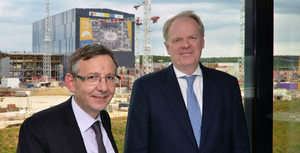What's happening at JET these days?
We have been in shutdown since November last year and will remain in shutdown until September, at which time we will be in a configuration to operate in deuterium-tritium. Of course, this doesn't mean that we have been idle: we are busy maintaining and refurbishing equipment, calibrating diagnostics, removing and analyzing samples—asking, for example, how much fuel, how much dust was retained from recent operations?
We are also building the infrastructure to accommodate a shattered pellet injector, currently being manufactured by Oak Ridge National Laboratory (US), which will allow researchers to study disruption mitigation scenarios.
In parallel, we are deeply involved in the analysis of the highly successful 2016 campaign and in preparation for deuterium-deuterium and tritium-tritium operation in 2018, and deuterium-tritium (DT) in 2019-2020.
For the preparation of these challenging experimental campaigns, we have set up a set of analysis and modelling campaigns where all EUROfusion scientists (around 300 involved) are welcomed to work jointly at the Culham site during dedicated weeks.
We don't often hear of tritium-tritium operation. Can you explain?
The mass of the particles plays an important role in the stability and in the energy transport within the plasma. We want to have a deeper understanding of these phenomena before going into nuclear operation with the deuterium-tritium mix.
In a nuclear plasma, deuterium (mass 2) makes up half of the particles and tritium (mass 3) make up the other half, which translates into an average particle mass in the plasma of 2.5.
In order to understand the behaviour of this nuclear plasma you can extrapolate from what you observe in pure deuterium plasmas. This is what fusion research does on a routine basis and what we will also be doing in 2018. But extrapolations lack accuracy. We'll get much more precise data by implementing a pure tritium plasma and interpolating the results from both deuterium and tritium plasmas.
But tritium is expensive ...
Indeed. We will have 60 grams of tritium on site. By recirculating it about a dozen times in our tritium plant, we'll be able to inject a total of approximately one kilogram throughout the whole campaign. But the actual burn, and hence the total consumption, will be tiny.



